The Indian system of spiritual and physical self-improvement of hatha yoga originated around the 11th century . However, in the form in which we know it, it began to take shape in the 1920s and 30s and continues to be supplemented and developed even now. These are simple yoga styles for biginners. Get the best after yoga tea for relaxing
With the right approach, hatha yoga classes harmonize the general state of mind and body , strengthening muscles, normalizing the functioning of internal organs and balancing the nervous system. However, it is important to remember that yoga exercises are aimed primarily at healthy people . If you have had injuries or have chronic diseases, you should consult a doctor before practicing, exercise with extreme caution and preferably under the guidance of a teacher.

Rules and recommendations
- Follow safety precautions: do not go beyond the current capabilities of your body and remember that pain is a stop sign. After all, yoga teaches us to establish contact with our body, assuming its soft and gradual improvement.
- Do not overdo it. If after class you only dream of collapsing on the sofa from fatigue, the load is chosen incorrectly. A proper yoga session is one after which you feel a surge of energy, or at least a pleasant languor, but not exhaustion.
- Regular practice is the key to success. You can start with two to three hour sessions a week and gradually increase the load. If you’re running out of time, try adding a 20-minute daily yoga workout to your schedule first.
Hatha Yoga Styles For Beginners
We offer you a set of 10 poses that are basic and suitable for any level of training. Stay in each pose for 30 to 60 seconds, or whatever time is comfortable for you. All movements should be unhurried and smooth, breathing – a little slower and deeper than your usual. Get the best after yoga tea for relaxing
In the article we will show:
- Tadasana – mountain pose
- Warrior pose I Virabhadrasana
- Triangle Pose (Trikonsana)
- Tree Pose (Vrikshasana)
- Downward facing dog (Adho Mukha Svanasana)
- Cobra Pose (Bhujangasana)
- Hare Pose (Shashankasana)
- Sage Marichi Pose (Marichiasana III)
- Full Boat Pose (Paripurna Navasana)
- Dead man’s Pose (Shavasana)
Mountain Pose (Tadasana)

- Stand straight with your big toes and heels together.
- Tighten the kneecaps, tighten the lower abdomen, “twisting” the tailbone slightly forward.
- Roll your shoulders back and down in a circular motion, opening your chest.
- Hands in good shape, fingers slightly apart.
- Lengthen your neck and point your chin slightly towards you.
- Pushing actively with your feet on the floor, stretch your entire body behind the crown of your head.
Warrior Pose (Virabhadrasana I)
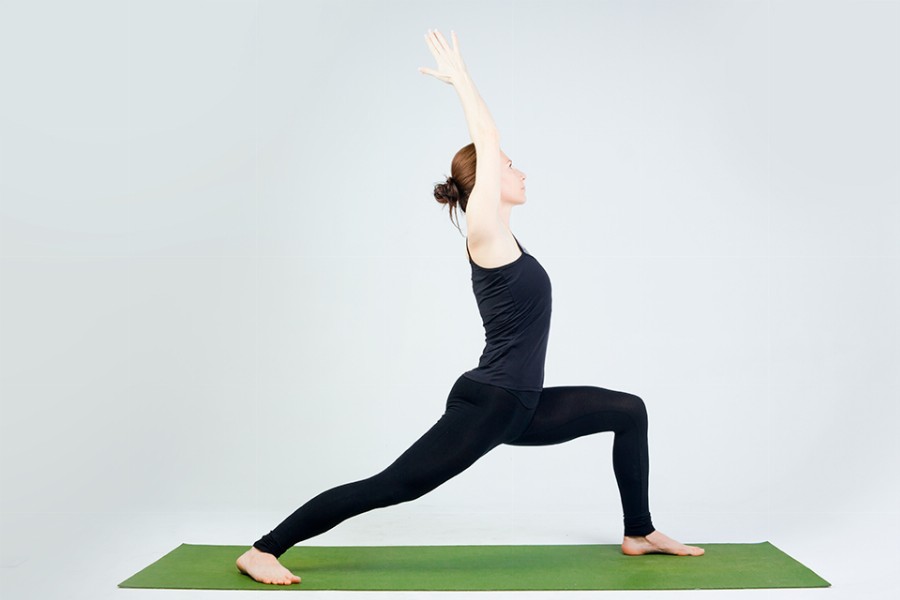
- Stand upright.
- Spread your left foot far wide.
- Tilt your right leg and upper body to the right.
- Bend your right knee to a 90 degree angle
- Press the left foot firmly to the floor, pointing the toe slightly towards the right foot.
- Raise your hands up slowly and face to the sky
- With each breath, try to stretch even more behind your arms, with each exhalation
- Return to an upright position when done and do the pose on the left leg.
Triangle Pose (Trikonsana)
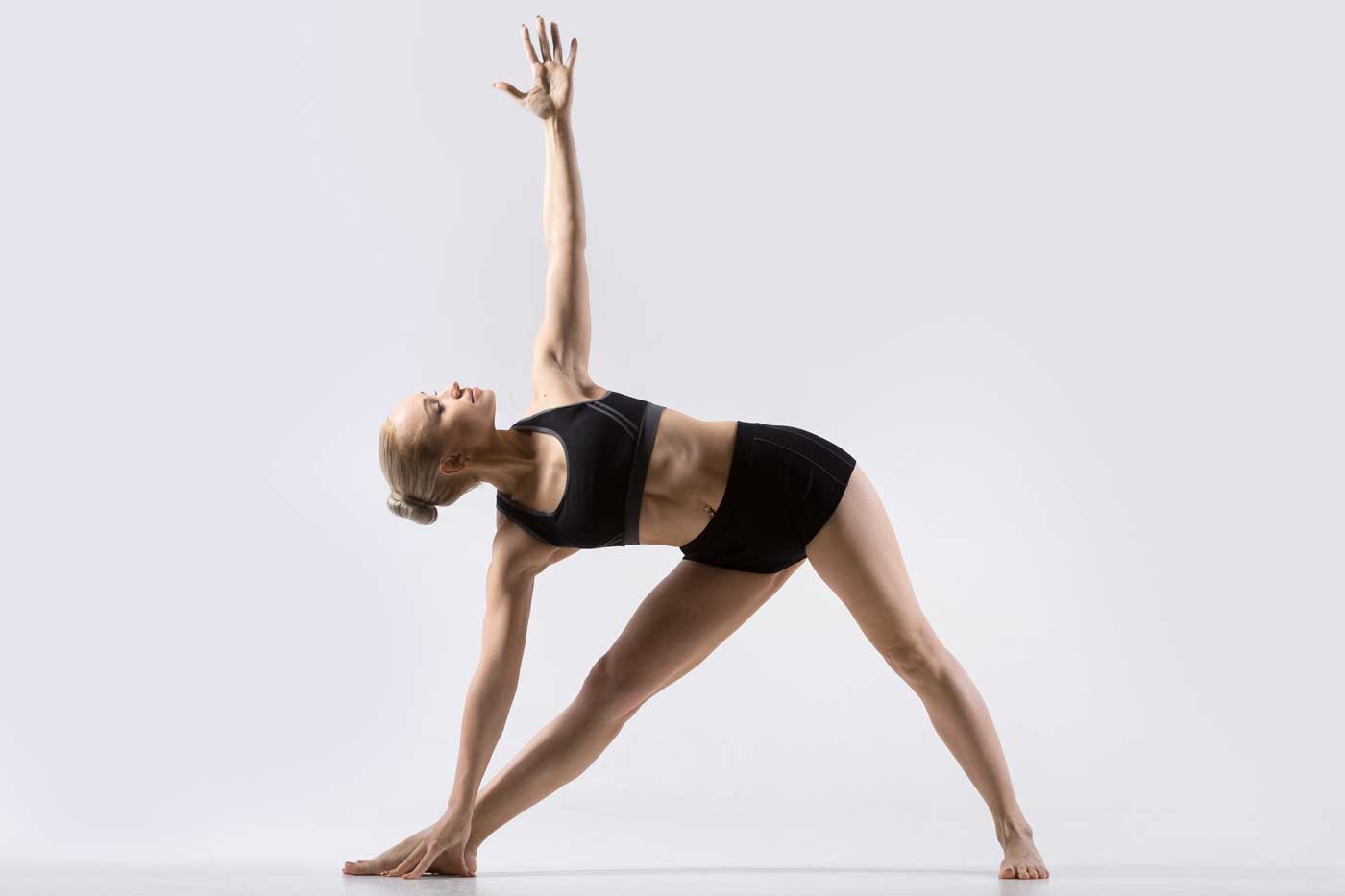
- Spread your feet at a distance equal to the length of one of your legs or slightly narrower.
- The right foot looks to the right, the toe of the left is turned slightly inward (as in the previous asana).
- The legs are straightened, the kneecaps are tightened.
- Stretch your arms in one line parallel to the floor and stretch to the right with an inhale. With an exhalation, lower your right hand to your right shin.
- The left hand tends upward, the gaze is directed to the thumb of the left hand. If you have neck problems, or if this head position causes pain, point your face down.
- If possible, lower your right hand to the floor. Make sure that the body does not fall forward – try to keep the whole body in the same plane.
- With an inhalation, rise and do the exercise on the other side.
Tree Pose (Vrikshasana)
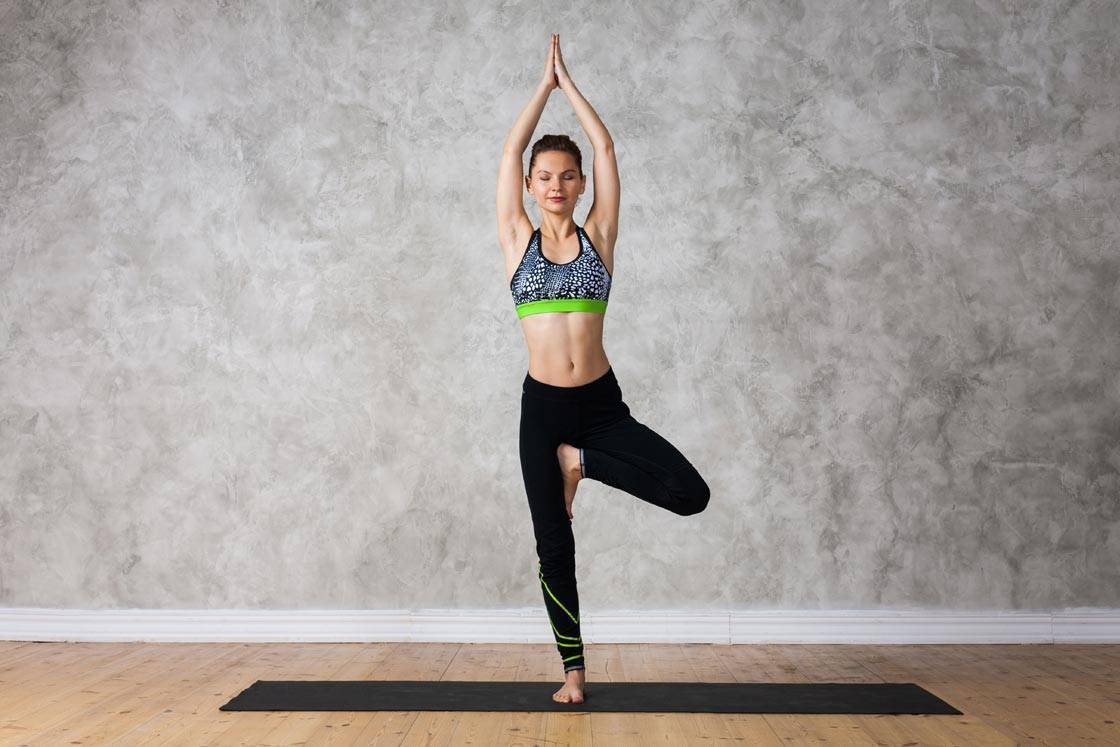
- Stand upright.
- Place the left foot on the inside of the right thigh with the heel as close to the perineum as possible.
- “Twist” the tailbone forward, pulling the lower abdomen.
- With an inhale, stretch your arms up and fold your palms above your head.
- Take your shoulders away from your ears, open your chest.
- Perform the pose on the other leg.
Downward facing dog (Adho Mukha Svanasana)

- Get on all fours so that your hands are on the floor and the sole of your both foot is flat on the ground.
- With an inhale and exhale, slowly crawl into a 60 degree angle position without bending you knees.
- The back and arms should form one straight line, the neck is relaxed, the lower abdomen is tucked up.
- Do not lower the shoulder blades; shoulders seem to tend to the front surface of the body.
- The palms are active, the fingers are pressed to the floor; feet are parallel to each other, or socks are wrapped slightly inward.
- If flexibility is still not enough to complete the pose, leave your heels off the floor and your knees slightly bent.
Cobra Pose (Bhujangasana)
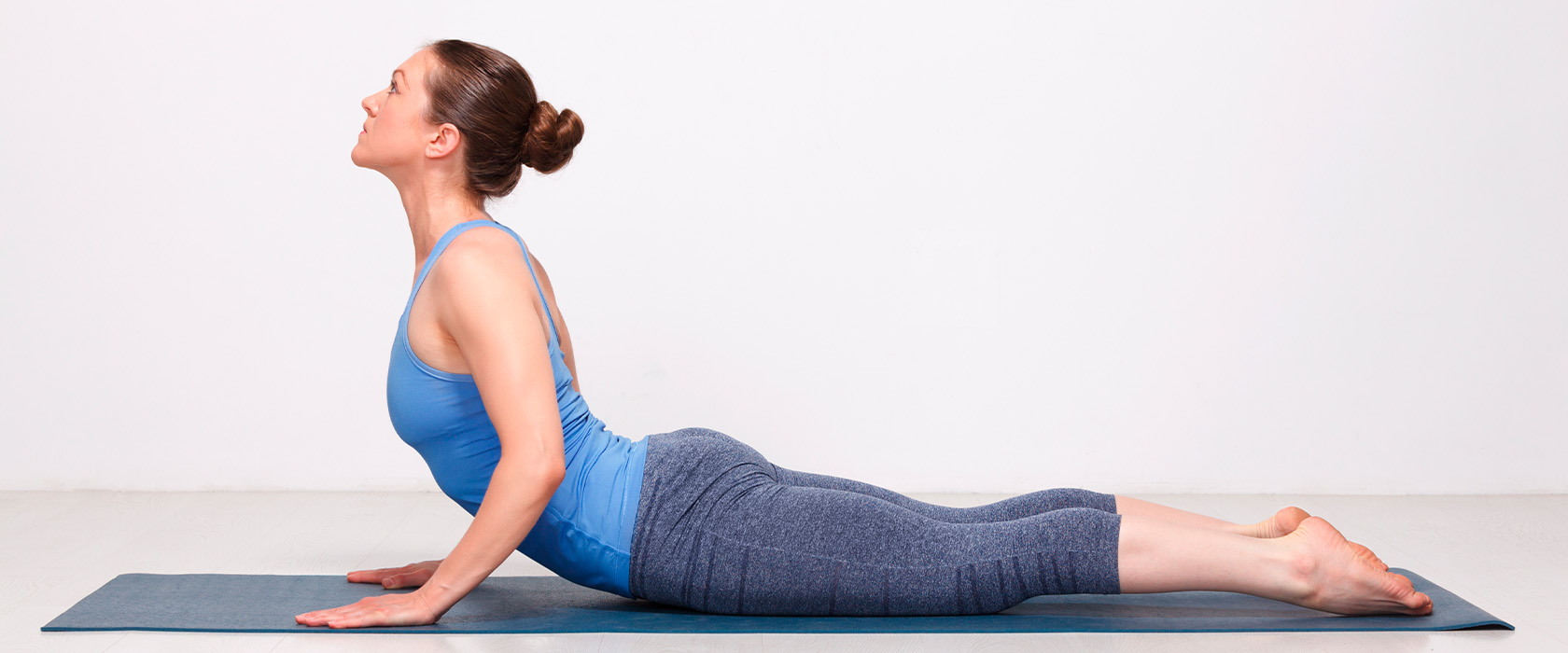
- Lying on your stomach, place your palms under your shoulders. Feet slightly narrower.
- With an inhale, lift up the upper part of the body from the floor. (there is a minimum pressure on the hands – they should only fix on the final position). The pubic bone should not come off the floor.
- Keep your elbows bent to prevent excessive arching of your lower back. Arms stay close to the body.
- Do not press your head into your shoulders and do not tilt back – the neck should organically continue to rest on the line of the spine.
- Hold for a few breaths and with an exhalation lower the body down, slowly bending your elbows.
Rabbit Pose (Shashankasana)
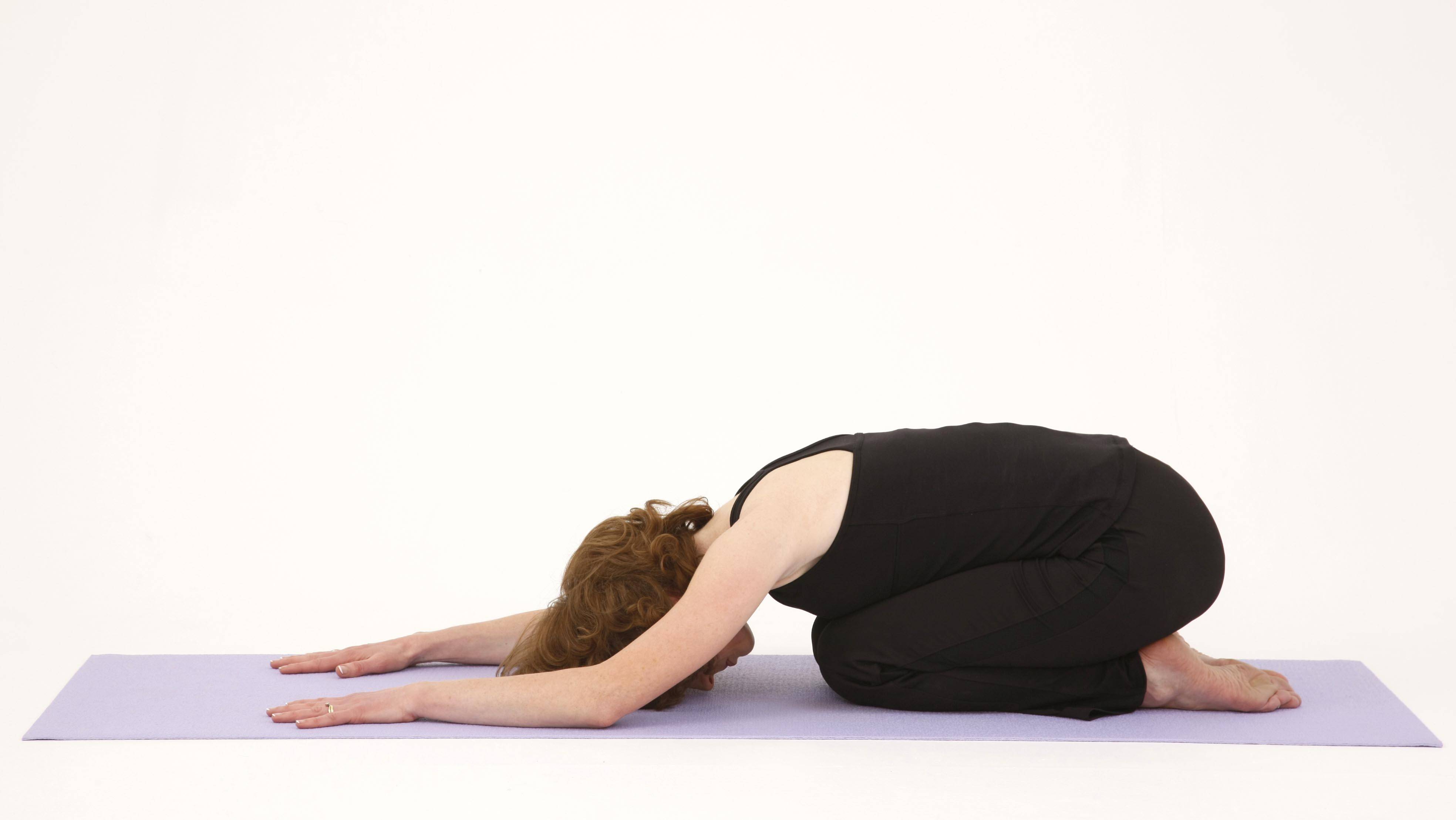
- Sit on your heels with your big toes together and your knees slightly apart.
- With an exhale, bend over and bring the body closer to the floor, placing the stomach and the lower part of the ribs between the thighs.
- Stretch your arms forward, lower your forehead to the floor. Take your shoulders away from your ears, round your lower back.
- With each breath, lengthen the spine, with each exhalation, try to pull the body a little more to the floor.
Sage Marichi Pose (Marichiasana III)

- Sit on the floor with your legs stretched out in front of you and your back straight.
- Bend your left leg and place your foot on the other side of your right knee.
- Stretch your left arm out and as you exhale, twist to the left, bringing your right shoulder behind your right knee.
- Take the next breath, and as you exhale, deepen the twist a little, lowering your arm to your thigh with your forearm facing upwards.
- Having fixed in this position, try to stretch a little more behind the crown with each breath, and with each exhalation – twist a little deeper.
- With an inhalation, slowly return to the starting position and twist to the other side.
Full Boat Pose (Paripurna Navasana)

- Sit on your buttocks, bend your knees and place your feet flat on the floor.
- Holding yourself with your hands under on the floor, tilt your body back so that a straight back forms an angle of 45 degrees with the floor.
- Lift your feet off the mat and bring your shins to parallel with the floor.
- Stretch your arms out in front of you, palms facing each other.
- If this position is comfortable for you, straighten your legs.
Dead Man’s Pose (Shavasana)

- Lie down your back with your arms and legs flat on the floor.
- Keeps arms and legs a little wide, close your eyes and relax.
One of the most important poses, despite the apparent simplicity. The fact is that we rarely manage to completely relax, and it is important to learn this skill so that our body and mind feel good.
These are some of the basic and yoga poses for beginners. This is to get you comfortable and prepared for the more challenging poses. If you have any underlying medical conditions don’t forget to check with your doctor before trying any of this. And, if you have any challenges beginning don’t forget to visit your local yoga coach closest to where ever you leave to get you started. Goodluck!!!!!
